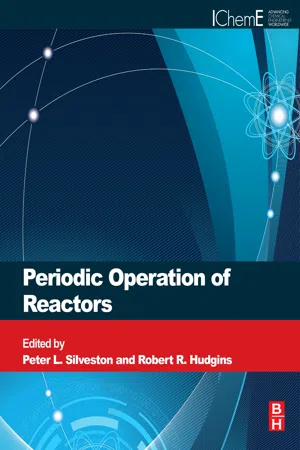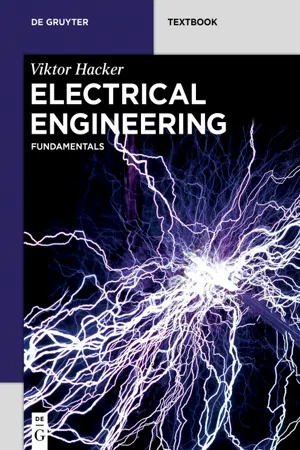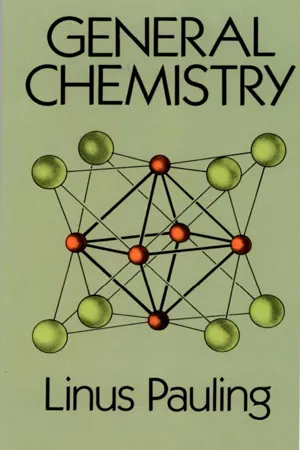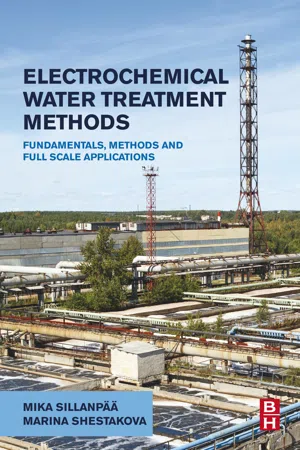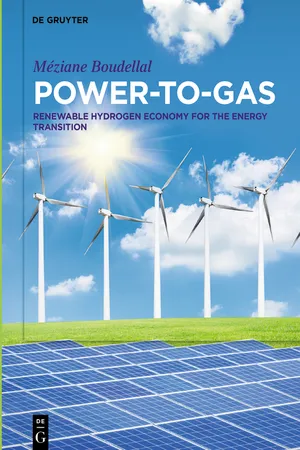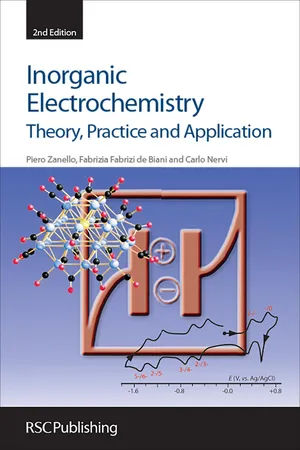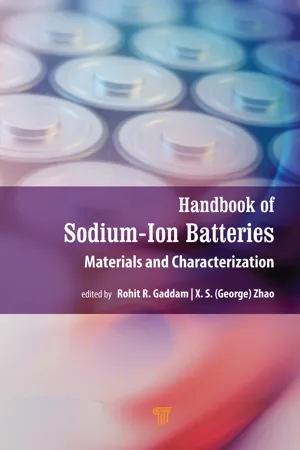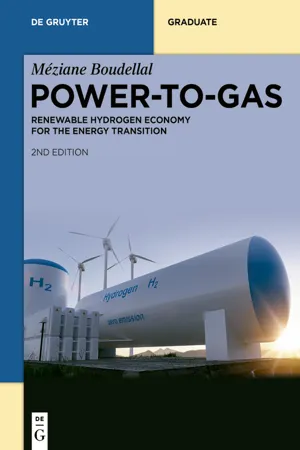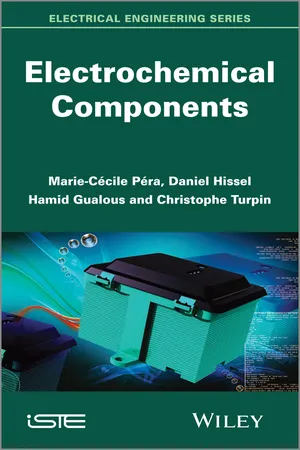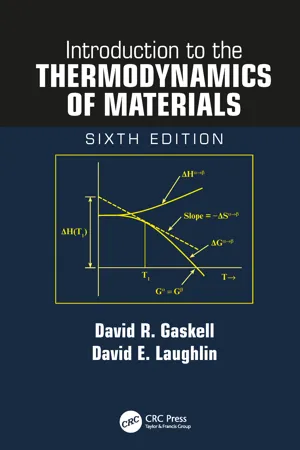Chemistry
Electrolysis
Electrolysis is a chemical process that uses an electric current to drive a non-spontaneous chemical reaction. It involves the decomposition of a compound into its elements or simpler compounds at the electrodes. This process is commonly used in various industrial applications, such as the production of metals and the purification of elements.
Written by Perlego with AI-assistance
Related key terms
Related key terms
1 of 4
Related key terms
1 of 3
11 Key excerpts on "Electrolysis"
- eBook - ePub
- P. L. Silveston, R. R. Hudgins(Authors)
- 2012(Publication Date)
- Butterworth-Heinemann(Publisher)
Silveston, 1998 ), has been known ever since the nineteenth century in electrochemistry. As alternating or pulsed current or potential, it has been applied commercially for more than a century. The operation has been applied primarily to electrolytic processes and to a lesser extent to galvanic ones. The objective of this chapter is to discuss periodic operation in electrochemical systems and thereby explore the potential for carryover of concepts or techniques into the engineering of non-electrochemical reaction systems. However, before doing so, let us consider some background on electrochemical processes and terminology.9.1.1 Electrochemistry Background
Fundamentals of electrochemistry are presented by a number of excellent textbooks (e.g., Newman and Thomas-Alyea, 2004 ; Scott, 1991 ; Bockris and Reddy, 1998a, b ; Bard and Faulkner, 2001 ). Puippe and Leaman (1986) provide a comprehensive overview of the principles and practice of pulse plating as of the mid-1980s.An electrochemical process is unique in that it involves redox reactions which lead to the movement of electrons and ions from one part of the system to another. Consequently, an electrochemical cell requires a connection between electronic conductors (i.e., electrodes, electrical connections) to allow the transport of electrons and an ionic conductor (i.e., electrolyte) which provides the transport of ions. The changeover from electronic charge transfer to ionic transfer within a cell takes place at the electrode/electrolyte interface where half-cell reactions involving both electrons and ions occur. At a minimum, electrochemical cells or processes require the following components: Electronic conductors consisting of two electrodes (anode and cathode) with electrical connections, ionically conducting phase(s) (i.e., electrolyte) and charge carriers (electrons and ions). Two types of electrochemical cells operate. In the first, an external electrical power source is connected to the electrodes to drive processes that would otherwise not occur. In the second, electrochemical reactions occur spontaneously to generate current and/or desired chemical products. To simplify this overview, certain items have been excluded—cells involving semiconductors where charge carriers other than electrons and ions are possible. - eBook - ePub
Electrical Engineering
Fundamentals
- Viktor Hacker, Christof Sumereder(Authors)
- 2020(Publication Date)
- De Gruyter Oldenbourg(Publisher)
Inside the cell, the charged ions migrate to the respective oppositely charged electrode through an electrolyte with ion conduction. A current flow is generated (ion current). 6.2 Electrolysis Electrolysis is a redox reaction provoked by electric current (inversion of processes of a galvanic cell); reduction and oxidation happen spatially separated. The electric current (direction of movement of positive charge carriers) is fed in through the anode 63 (positive pole) and is discharged at the cathode (negative pole). Between the two electrodes an electric field and ionic migration occurs. The negatively charged ions (anions) migrate to the anode where they are oxidised. During this process, electrons are emitted. The positive ions (cations) migrate towards the cathode where they are reduced. During this process, electrons are absorbed. Electrolysis is used to produce hydrogen and extract (pure) metals, among others. 6.2.1 Electrolysis of water During the Electrolysis of water, hydrogen (H 2) is produced at the cathode and oxygen (O 2) is produced at the anode. Through the addition of e.g. caustic potash solution, sulphuric acid or sodium chloride water becomes an electrolyte with ion conductivity. H 3 O + and OH - ions are created (also through autoprotolysis). The positive ions (H 3 O +, cations) move towards the cathode (negative) where they absorb an electron, producing H 2. The negative ions (OH -, anions) move towards the anode (positive) where they emit an electron, producing O 2. The total electric charges of the protons and electrons amount to zero (in the closed system). The complete partial reactions are as. follows: A u t o p r o t o l y s i s : 2 H 2 O → H 3 O + O H − A n o d e : 2 O H − → 1 2 O 2 + H 2 O + 2 e − o r 3 H 2 O → 1 2 O 2 + 2 H 3 O + + 2 e − C a t h o d e : 2 H 2[--=PL. GO-SEPARATOR=--]O + 2 e − → H 2 + 2 O H − o r H 3 O + + e − → 1 2 H 2 + H 2 O O v e r a l l r e a c t i o n : H 2 O → H 2 + 1 2 O 2 In the fuel cell (e.g - eBook - ePub
- Linus Pauling(Author)
- 2014(Publication Date)
- Dover Publications(Publisher)
15 Oxidation-Reduction Reactions. Electrolysis It was mentioned in Section 6-8 that in the period from 1884 to 1887 Svante Arrhenius developed the theory that electrolytes (salts, acids, bases) in aqueous solution are dissociated into electrically charged atoms or groups of atoms, called cations and anions, and some of the properties of these solutions were discussed in Section 13-11. The present chapter is devoted in part to the phenomena involved in the interaction of molten salts and ionic solutions with an electric current. It is found that the electron reactions that take place at electrodes can be described as involving oxidation or reduction of atoms or groups of atoms, and that the chemical reactions called oxidation-reduction reactions (sometimes shortened to redox reactions) can often be conveniently described in terms of two electrode reactions. 15-1. The Electrolytic Decomposition of Molten Salts The discovery of ions resulted from the experimental investigations of the interaction of an electric current with chemical substances. These investigations were begun early in the nineteenth century, and were carried on effectively by Michael Faraday (1791-1867), in the period around 1830. The Electrolysis of Molten Sodium Chloride Molten sodium chloride (the salt melts at 801°C) conducts an electric current, as do other molten salts. During the process of conducting the current a chemical reaction occurs; the salt is decomposed. If two electrodes (carbon rods) are dipped into a crucible containing molten sodium chloride and an electric potential, from a battery or generator, is applied, metallic sodium is produced at the cathode and chlorine gas at the anode. Such electric decomposition of a substance is called Electrolysis. The Mechanism of Ionic Conduction Molten sodium chloride, like the crystalline substance, consists of equal numbers of sodium ions and chloride ions. These ions are very stable, and do not gain electrons or lose electrons easily - eBook - ePub
Understanding Molecules
Lectures on Chemistry for Physicists and Engineers
- Franco Battaglia, Thomas F. George(Authors)
- 2018(Publication Date)
- CRC Press(Publisher)
14 ElectrochemistryIn previous chapters, upon treating the energetic features of chemical reactions, we have seen that they are generally accompanied by heat exchanges (heat production in exothermic reactions and heat absorption in endothermic reactions). Electrochemistry is concerned with reactions proceeding with the production or consumption of electric energy: clearly, at least from a thermodynamic point of view, electrochemical reactions differ from ordinary chemical reactions so far considered.Let us consider, for example, the reactionZ n + Cu→ Z2 +n+ C u .2 +( 14.1 )This entails a transfer of electrons from zinc to copper. However, when it occurs as an ordinary chemical reaction, the reactants, via some suitable, possibly multi-step, collision process, bring themselves into intimate contact with each other. Thus, the path travelled by the electrons is on the order of the interatomic distances between the colliding species; moreover, collisions occur in a chaotic manner, and only some of these have sufficient energy to either overcome the potential barrier (activation energy) pertaining to the process or allow effective electron tunneling.It is clear that, as long a reaction of the type (14.1 ) proceeds as just described, it cannot be used to produce an electric current, since the energy produced is in the form of heat. The desired electric current does require a transfer of electrons, but it must occur with a non-chaotic charge flux, guided along a given direction, and along a path entailing macroscopic distances, much larger than the typical intermolecular distances between the colliding reactants. In order for something like this to be possible, it is first necessary that the reactants be kept spatially separated from each other; moreover, the reaction must occur in an experimental arrangement ensuring a continuous flux of charges (namely the desired electric current). Such an experimental arrangement is called an electrochemical system : it is a Galvanic cell if electric current is produced by a chemical reaction, and an electrolytic cell - eBook - ePub
Electrochemical Water Treatment Methods
Fundamentals, Methods and Full Scale Applications
- Mika Sillanpaa, Marina Shestakova, Mika Silanpää, Mika Sillanpää(Authors)
- 2017(Publication Date)
- Butterworth-Heinemann(Publisher)
2+ ) is possible only at the time of the collision. The electron path will be very short and this is the second feature of the chemical process. Collisions can occur at any point of the reaction volume and in all relative positions of reacting species, so the electronic transitions can be performed in any direction in space. Randomness of particle collisions and electron transfer are the third feature of the chemical reaction. As a result of these peculiarities the energy effect of the chemical reaction is expressed in the form of release or absorption of heat. It is necessary to set certain conditions in the system to convert energy from chemical reactions to electrical energy, i.e., to create an electrochemical process.In electrochemical processes, the transfer of electrons from one reactant to another is performed over a significantly long path. It is explained by the fact that production and consumption of electric energy is always associated with the passage of electric current, which is a stream of electrons traveling along the same path. Therefore, spatial separation of the reactants (reducing and oxidizing agents) is required for electrochemical processes to keep electrons flow from reducing to oxidizing agents. In this regard, direct contact between reactants should be replaced with the two metal plates connected to each other by a metallic conductor. To ensure the continuous passage of electric current through the reactionary space, charge carriers having a high ionic conductivity should be present or added in the reactionary solution. Thus, a system called an electrochemical cell is required to conduct electrochemical reactions.Wastewater treatment by electrochemical methods is based on conducting the Electrolysis process. To conduct the Electrolysis an external source of electrical energy is required to generate and maintain a proper potential and as a result electrochemical reactions at anode and cathode, which are placed into electrochemical cell (for example, into industrial electrolyzer). Michael Faraday was the first scientist who investigated the relationship between amount of electric charge Q (current I multiplied by time t ) passed through the electrode/electrolyte solution interface and chemical reactions caused by this charge. In 1832 Faraday reported that the amount of electricity required to produce a given quantity of substances does not depend on the electrode size, number of working electrodes, and the distance between electrodes. It was stated that the mass m of the substance liberated at an electrode is directly proportional to the electric charge Q , passed through the electrolyte and directly proportional to the equivalent weight (M/z ) of the element for a given amount of electricity (1.13) - eBook - ePub
- Méziane Boudellal(Author)
- 2018(Publication Date)
- De Gruyter(Publisher)
4ElectrolysisDiscovered in 1800 by the English Nicholson and Carlisle, continuous Electrolysis, which comes from Greek words (ἤλεκτρον [electron] “amber” and λύσις [lýsis] “dissolution”), allowed the production of hydrogen in large volumes. The reforming of natural gas and hydrocarbons or the gasification of coal then supplanted it, except in countries where electricity is abundant (e.g. Canada).4.1Basic principle
The key element of the power-to-gas chain is the electrolyser that allows the production of hydrogen from surplus renewable electricity. The electrolysers used can be grouped into two main families: alkaline and PEM (proton exchange membrane ), whose characteristics will be described in detail. Other technologies are under evaluation or in development such as high-temperature Electrolysis.4.2Chemical reactions
The decomposition of water by electricity makes it possible to separate hydrogen and oxygen according to the reactionThe energy to be supplied for the dissociation of water consists of electrical and thermal energies:2H 2O( 1 )+ e n e r g y ⇒ 2H 2( g )+O 2( g )( 4.1 )2H 2O +[⇒ 2237 ⋅ 2 k J / m o l o f e l e c t r i c i t y + 48.6 k J / m o l o f h e a t]H 2+O 2( 4.2 )An Electrolysis unit comprises an electrolyte and two electrodes separated by a membrane or diaphragm (Figure 4.1 ).In an electrochemical cell (Figure 4.2 ), water is decomposed if a certain voltage (critical voltage) is applied between the two electrodes.At equilibrium, there is always a partial dissociation of water into H+ and OH– ions. In alkaline medium, OH– - eBook - ePub
Inorganic Electrochemistry
Theory, Practice and Application
- Piero Zanello, Carlo Nervi, Fabrizia Fabrizi de Biani(Authors)
- 2019(Publication Date)
- Royal Society of Chemistry(Publisher)
Part 1:Basic Aspects of Electrochemistry
Passage contains an image CHAPTER 1 Fundamentals of Electrode Reactions
Electrochemistry is essentially based on the relationships between chemical changes and flows of electrons (i.e. the passage of electricity). In this connection it is well known that electron-transfer processes play an essential role in many physical, chemical and biological mechanisms and several such examples will be illustrated in the text. Perhaps in no other field of chemical reactivity can one look for and find so many relationships between theory and experimental measurements.Two disciplines cover the majority of the theoretical and practical aspects of the mechanisms through which electron transfers proceed: electrochemistry and photochemistry. This book considers only mechanisms relating to electrochemistry.1.1 ELECTRON-TRANSFER REACTIONS
In a purely formal manner the description of an electron-transfer event, such as the reduction in solution of Fe(III ) ion, can be written in two ways, depending on whether the reduction is operated by a chemical agent or by an electrode:- through a reducing agent (redox reaction in a homogeneous phase):
- through an electrode (redox reaction in a heterogeneous phase):
In both cases, the adopted symbolism only gives a picture of the overall process. In fact, mechanistically, the redox reactions (as with any other type of reaction) proceed by a series of intermediate steps involving phenomena such as: - eBook - ePub
Handbook of Sodium-Ion Batteries
Materials and Characterization
- George Zhao, Rohit R. Gaddam, George Zhao, Rohit R. Gaddam(Authors)
- 2023(Publication Date)
- Jenny Stanford Publishing(Publisher)
Chapter 2 Principles of Electrochemistry Nisha Garg, Venkatasailanathan Ramadesigan, and Sankara Sarma V. Tatiparti Department of Energy Science and Engineering, Indian Institute of Technology Bombay, Mumbai 400076, India [email protected]Electrochemistry is a branch of physical chemistry that studies the chemical changes that occur due to the flow of electrical current. The flow of current, caused by a random chemical reaction or the chemical reaction caused by an external electricity supply, is an example of an electrochemical reaction. Electrochemical processes are the basis for large-scale chemical and metallurgical production of materials, metallic corrosion, power sources, and industrial metal finishing. Batteries and fuel cells are prime examples of electrochemical devices that convert chemical energy into electrical energy. Primary and secondary batteries are the backbone of today’s engineering devices that require energy storage.Energy storage systems are fast emerging as an essential part of the evolving clean energy systems of the 21st century. Energy storage represents a huge economic opportunity and could help countries achieve their emission reduction targets by shifting to renewablebased generation. Most of the portable devices we see around us, such as laptops, mobile phones, watches, cars, and inverters, have one of these kinds of electrochemical storage systems. Therefore, it is the need of the hour to understand the basics of these electrochemical energy storage systems or specifically batteries. We discuss the underlying electrochemical principles of the working of batteries in this chapter. This understanding will eventually help us in designing better energy storage systems for future needs.2.1 Electrochemical Cells
Electrochemical cells contain two electrodes, called the anode and the cathode. The electrode where oxidation occurs is called the anode, and the cathode is where reduction takes place. Electrodes are usually made from conductive materials, including metals, semiconductors, and graphite. The electrolyte is filled between these two electrodes, which contains ions that can freely move. A porous separator usually separates the two electrodes. An electrochemical cell can be of two types: galvanic or voltaic cell and electrolytic cell. In the case of galvanic/voltaic cells, the decrease in free energy during the spontaneous redox chemical reaction is converted into electrical energy. On the other hand, in an electrolytic cell, a nonspontaneous chemical reaction is driven by an external source of current, thus converting electrical energy into chemical energy. - eBook - ePub
Power-to-Gas
Renewable Hydrogen Economy for the Energy Transition
- Méziane Boudellal(Author)
- 2023(Publication Date)
- De Gruyter(Publisher)
4 ElectrolysisDiscovered in 1800 by the English Nicholson and Carlisle, continuous Electrolysis, which comes from Greek words (ἤλεκτρον [electron] “amber” and λύσις [lýsis] “dissolution”), allowed the production of hydrogen in large volumes. The reforming of natural gas and hydrocarbons or the gasification of coal then supplanted it, except in countries where electricity is abundant (e.g. Canada).4.1 Basic principle
The key element of the power-to-gas chain is the electrolyser that allows the production of hydrogen from surplus renewable electricity. The electrolysers used can be grouped into two main families: alkaline and proton exchange membrane (PEM), whose characteristics will be described in detail. Other technologies are under evaluation or in development such as high-temperature Electrolysis.4.2 Chemical reactions
The decomposition of water by electricity makes it possible to separate hydrogen and oxygen according to the reaction:(4.1)The energy to be supplied for the dissociation of water consists of electrical and thermal energies:2H 2O 1+ e n e r g y⇒ 2H 2g +O 2g(4.2)2H 2O +237⇒ 2.2 k J / m o l o f e l e c t r i c i t y + 48.6 k J / m o l o f h e a tH 2+O 2An Electrolysis unit comprises an electrolyte and two electrodes separated by a membrane or diaphragm (Figure 4.1 ).Figure 4.1: Principle of water Electrolysis.In an electrochemical cell (Figure 4.2 ), water is decomposed if a certain voltage (critical voltage) is applied between the two electrodes.Figure 4.2: Principle of an electrochemical cell (alkaline Electrolysis).At equilibrium, there is always a partial dissociation of water into H+ and OH– ions. In alkaline medium, OH– - eBook - ePub
- Marie-Cécile Pera, Daniel Hissel, Hamid Gualous, Christophe Turpin, Marie-Cécile Pera, Daniel Hissel, Hamid Gualous, Christophe Turpin(Authors)
- 2013(Publication Date)
- Wiley-ISTE(Publisher)
Chapter 1
Basic Concepts of Electrochemistry used in Electrical Engineering
1.1. Introduction
The aim of this chapter is to lay down some basic concepts of electrochemistry which are necessary in order to understand the behavior of the electrochemical components described in this book. For a detailed presentation, the reader could be helped by referring to specialized books such as [DIA 96; LEF 09].1.2. Brief description and principles of operation of electrochemical components
1.2.1. Principle of operation [TUR 08]
Every electrochemical component is made up of a positive electrode and a negative electrode, separated by an electrolyte which may be either liquid or solid (see Figure 1.1 ). Conventionally, with generators, it is the positive electrode from which the current originates when functioning in generator mode.Generally speaking, an electrochemical component can operate as an electric generator or an electric load, or both if it has reversible function.Figure 1.1. Principle of operation of electrochemical components [TUR 08]In short, the component is the site of an oxidation/reduction reaction which involves two “redox” pairs. More specifically, each electrode is the site of oxidation (loss of electrons) or reduction (gain of electrons) depending on the direction of the current flowing through the component (Figure 1.1e ). The n electrons released by the oxidation reaction occurring in an electrode circulate from that electrode to the other via the external electrical circuit. Simultaneously to this circulation of electrons, and in the same direction, the n ions from the electrode being oxidized circulate toward the other electrode through the electrolyte. Thus, the reduction reaction is able to take place on the other electrode.The electrodes need to be good electrical conductors. The electrolyte has to be a good ion conductor and a good electron insulator, in order to avoid any short-circuits between the two electrodes. In the case of a liquid electrolyte, a separator is usually used to electrically insulate the two electrodes. The reactions consume reactants and form products, which have to be respectively brought to and evacuated from the reaction area. - eBook - ePub
- David R. Gaskell, David E. Laughlin(Authors)
- 2017(Publication Date)
- CRC Press(Publisher)
involves a decrease in the valence state of A from +2 to 0 and an increase in the valence state of B from 0 to +2. The reaction involves the transfer of two electrons from B to A and hence can be written asThe change in free energy is thus a manifestation of the energetics of electron transfer. The reaction equation, written as the sum ofA+ B =2 +B+ A2 +andA+ 22 +e –= AB – 2e –=B2 +suggests the possibility of conducting the reaction as shown in Figure 14.1 . A mixture of A + AO and a mixture of B + BO are joined by two connections a and b , where a is an electronic conductor through which only electrons can pass and b is an ionic conductor through which only oxygen ions can pass. The spontaneous reaction thus occurs in the following manner. Two electrons leave a B atom, travel from right to left along a and, on arrival at the A + AO mixture, convert an A2+ ion to an A atom. Simultaneously, an O2– ion leaves the A + AO mixture and passes through b to the B + BO mixture. Charge neutrality in the overall system is thus maintained, and the overall reaction can be written asFigure 14.1 A schematic representation of an electrolytic reaction.A 2+O 2– + B =B2 +O+ A2 –As a result of its being conducted in an electrochemical manner, this reaction is called an electrochemical reaction . The driving force for the transport of electrons along a is manifested as an electric voltage (or difference in electric potential) which can be measured by placing an external opposing voltage in the circuit a and adjusting this voltage until no electric current flows, at which point the electrochemical reaction ceases. At this point, the external voltage exactly balances the voltage generated by the electrochemical system; that is, the thermodynamic driving force for the chemical reaction is exactly balanced by the externally applied electric driving force. Knowledge of the mathematical relationship between these two types of forces allows the former (ΔG for the reaction) to be measured. Furthermore, whereas in Chapter 12
Index pages curate the most relevant extracts from our library of academic textbooks. They’ve been created using an in-house natural language model (NLM), each adding context and meaning to key research topics.
Explore more topic indexes
Explore more topic indexes
1 of 6
Explore more topic indexes
1 of 4
